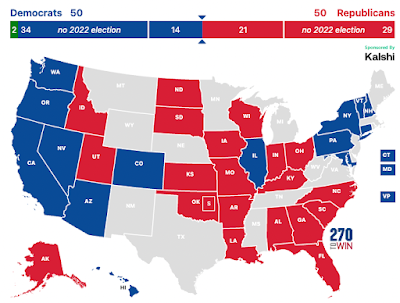The 2016 Projection: Hillary's day finally comes
 |
| Clinton 323, Trump 217 |
Since it became clear that Donald Trump would win the Republican nomination in June, I have been about 80% certain that Hillary Clinton would beat him in the General Election. So I put my money where my mouth is, buying stock in Clinton the day before the Democratic Convention when the price was $0.64 to win $1.00, in essence a 64% chance of winning.
Like any good scientist, I was prepared to factor new information into my view. But the real threats to Hillary's candidacy (an indictment from the FBI investigation, a Lehman Brothers like collapse, etc.) never materialized. On Twitter, I doubled down on this confidence a number of times in response to particulary silly moments in the news cycle, such as when Hillary was struck was pneumonia...
If you're a bettor, feel free to cash in on this ridiculous news cycle that has Hillary's chances at $0.64 to pay $1 https://t.co/nWJbkxXoNK— Alex Garlick (@garlicksauce) September 13, 2016
or when FBI Director James Comey (who someone will win a Best Supporting Actor Emmy for playing when the HBO movie is made about this campaign) cryptically "reopened" the email investigation at the end of October.
Finally, here are three thoughts from this cycle:A reasonable response to today's news is to buy HRC on the prediction markets. https://t.co/ipv3ICMXSN pic.twitter.com/aU0b7dlDju— Alex Garlick (@garlicksauce) October 28, 2016
1) The times Clinton lagged (like the Pneumonia episode), usually fell during a time when there was little actual news. By "news", I mean events like the debates where there was new information available. Trump's ability to flood the media with outrageous statements at his rallies proved to be more effective than I previously assumed it could be.
He weaponized the speed of the modern news cycle. There was always a flurry of reporting on the latest demographic group or public figure he attacked, such that he could avoid losing any individual news cycle by too much. In political science terms, he was able to shift the scope of conflict when it was not going his way by opening a new one.
In the end, individual voters seemed to dwell on a single episode (the Khan family, Mexicans are "rapists", and the Billy Bush tape seemed to resonate the most), and when aggregated together, he never grew his appeal beyond the Republican base.
2) The map. I see two important trends from the Kerry and Obama elections to this Clinton election. First, is states like Ohio and Iowa that Trump is poised to win that Obama won. I subscribe to the belief that white, non-college educated voters have moved towards the Republican party, which is seen here. However, this trend is countered by two, arguably more substantial trends. The first is the growth of the Latino vote, which gives me confidence Democrats will win Nevada, and in future cycles will compete in Arizona and eventually Texas (mark it down Texas will be the most important electoral college state in 2028 or so). Second, is the growth of liberal votes in major urban centers, like Philadelphia and Pittsburgh that will power Clinton in Pennsylvania.
3) The Senate. Much harder to know. My best guess is that the Democrats take the Senate with 51 seats (Dems win NH, PA, IN, WI, NV and lose FL, MO, NC). But 50-50 might be the most likely outcome. Despite this rosy prediction for the Democrats, I don't think they will win the US House. Not because of gerrymandering (although that plays a part), but because they didn't run enough competitive candidates to capitalize on what will be a strong national vote. (I bet Clinton will win by 2-4% total).
Now get out there and vote!
